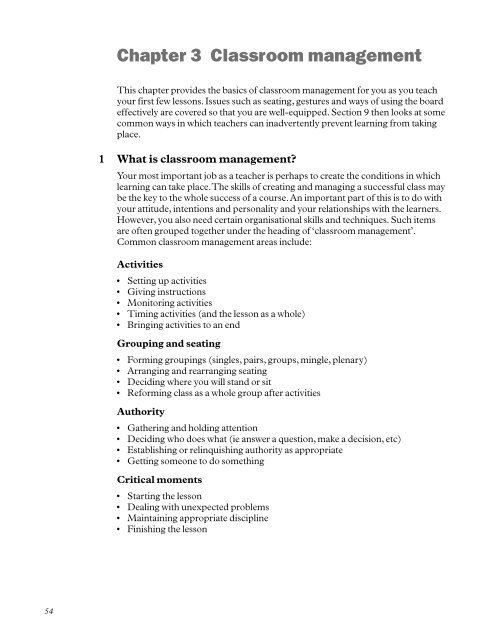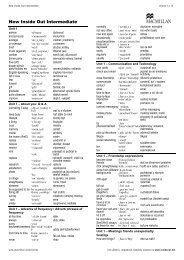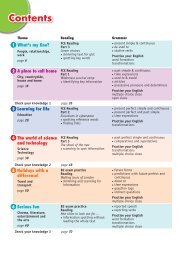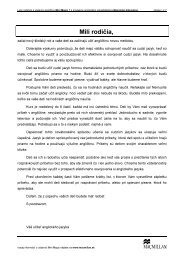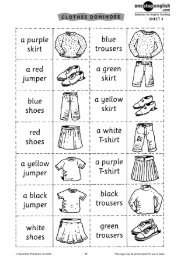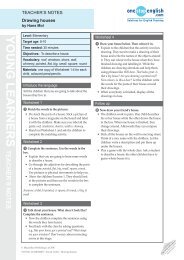Chapter 3 Classroom management - Macmillan English
Chapter 3 Classroom management - Macmillan English
Chapter 3 Classroom management - Macmillan English
You also want an ePaper? Increase the reach of your titles
YUMPU automatically turns print PDFs into web optimized ePapers that Google loves.
<strong>Chapter</strong> 3 <strong>Classroom</strong> <strong>management</strong>This chapter provides the basics of classroom <strong>management</strong> for you as you teachyour first few lessons. Issues such as seating, gestures and ways of using the boardeffectively are covered so that you are well-equipped. Section 9 then looks at somecommon ways in which teachers can inadvertently prevent learning from takingplace.1 What is classroom <strong>management</strong>?Your most important job as a teacher is perhaps to create the conditions in whichlearning can take place. The skills of creating and managing a successful class maybe the key to the whole success of a course. An important part of this is to do withyour attitude, intentions and personality and your relationships with the learners.However, you also need certain organisational skills and techniques. Such itemsare often grouped together under the heading of ‘classroom <strong>management</strong>’.Common classroom <strong>management</strong> areas include:Activities• Setting up activities• Giving instructions• Monitoring activities• Timing activities (and the lesson as a whole)• Bringing activities to an endGrouping and seating• Forming groupings (singles, pairs, groups, mingle, plenary)• Arranging and rearranging seating• Deciding where you will stand or sit• Reforming class as a whole group after activitiesAuthority• Gathering and holding attention• Deciding who does what (ie answer a question, make a decision, etc)• Establishing or relinquishing authority as appropriate• Getting someone to do somethingCritical moments• Starting the lesson• Dealing with unexpected problems• Maintaining appropriate discipline• Finishing the lesson54
1 What is classroom <strong>management</strong>?Tools and techniques• Using the board and other classroom equipment or aids• Using gestures to help clarity of instructions and explanations• Speaking clearly at an appropriate volume and speed• Use of silence• Grading complexity of language• Grading quantity of languageWorking with people• Spreading your attention evenly and appropriately• Using intuition to gauge what students are feeling• Eliciting honest feedback from students• Really listening to students<strong>Classroom</strong> <strong>management</strong> involves both decisions and actions. The actions arewhat is done in the classroom, eg rearranging the chairs. The decisions are aboutwhether to do these actions, when to do them, how to do them and who will dothem.At any classroom moment, there will be a range of options as to possible actions.To say one thing or to say something different. To stop an activity or to let itcontinue for a few more minutes. To take three minutes to deal with a difficultquestion or to move on with what you had previously planned. To tell off alatecomer or to welcome him. To do something or to do nothing. These optionscontinue throughout the lesson; at every step, your decision will take you forwardon your particular route. No one can tell you the ‘right’ way to do something.There is no perfect lesson, no single correct answer, no single route through alesson, though some routes may in the end prove to be much more effective thanothers. Different people or different situations create different solutions. Your totallesson is created by your choices. You cannot know whether alternative routesmight have been more effective – but, post-lesson, it’s useful to reflect on what youdid and didn’t do – and let this inform your future lessons.The essential basic skill for classroom <strong>management</strong> is therefore to be able to lookat and read classroom events as they occur and think of possible options availableto you, to make appropriate decisions between these options, and to turn theminto effective and efficient actions. As you grow in experience, your awareness ofpossible options will grow.Thus the basic skills of classroom <strong>management</strong> can be summarised as follows:LookLooking atclassroom eventsminuteby minuteOptionsFinding optionsMaking decisionsbetween oneoption andanother?????ActionsDoing thechosen actionFigure 3.1Basic skills of classroom <strong>management</strong>55
<strong>Chapter</strong> 3 <strong>Classroom</strong> <strong>management</strong>Task 3.1Choosing classroom <strong>management</strong> optionsWrite two or more options for the following situations:1 A student says I don’t want to do this exercise.2 You expected an activity to take five minutes. It has taken twenty so far, and thestudents still seem to be very involved. There is something else you would like todo before the lesson ends in ten minutes.3 The students are working in groups of three. Two groups have finished the taskyou set them and are now sitting looking bored. The other groups still seem tohave a long way to go before they finish.CommentaryHere are a few possible options:1 You could say Fine.You could say loudly Do it!You could ask why the student doesn’t want to do it.You could offer an alternative exercise or activity.You could say Choose something you’d like to do.You could explain the point of the exercise.Note that in all the above options, you also have further options regarding yourattitude and behaviour: ie you could be patient or impatient, defensive or open,sound as if you mean it or sound as if you don’t.2 You could stop the activity.You could let it continue (postponing the next activity).You could announce a time for finishing (eg Two more minutes).You could ask the students how much longer they need.You could offer the students the option of stopping and doing something else.3 You could tell the groups which have finished that they can chat or dosomething else while the other groups finish.You could give the groups which have finished a short extra task to keep thembusy until the rest finish.You could set a time limit (say two minutes) for the others to finish.You could bring the groups which have finished together to compare theiranswers with each other.Task 3.2 Selecting alternative optionsRead this description of a classroom situation and consider any alternative optionsavailable to you at points (a) and (b).You come into the classroom at the start of the lesson. There are 25 teenagestudents in the room. About half of them seem very involved in a loud discussion (intheir own language, not <strong>English</strong>) about a current political situation. (a) You shoutout OK, OK, let’s start the lesson; you can continue that later. The room quietensdown a bit; some people continue whispering animatedly to each other. Now, todaywe are going to look at ways of talking about the future, you continue. One studentasks, But this subject is very interesting. Could we continue the conversation if weuse <strong>English</strong>? (b) You say, I’m sorry, but we have to get through Unit 9 of the booktoday. Perhaps we can have a discussion next week. Open your books at page 47.56
1 What is classroom <strong>management</strong>?CommentaryThe following are a few of the many possible options for (a):• You sit down and wait for the class to conclude the discussion in its own time,waiting until they indicate that they are ready for you to start.• You join in the conversation, but using <strong>English</strong>.• You join in the conversation using <strong>English</strong> and subtly manipulate the discussionso that the students are involved in using the language items you were planningto work on in the first place. You join in the conversation using <strong>English</strong>. After awhile you slip into your conversation one or two examples of the language itemsyou had planned to focus on in the lesson. Draw students’ attention to theseitems and slowly change the focus of the lesson so that the students get involvedin using the language items you were planning to work on in the first place.• You stand in front of the class in a way that indicates that you want theirattention (making eye contact with as many people as possible, lookingauthoritative, etc) and wait for silence. Having established silence, you put tothe class the decision about what to do: We can either continue the discussion or dowhat I have planned to do. Which would you prefer?Here are some options for (b):• You say OK.• As in the fourth option above, you ask the class to make the decision about whatto do.• You explain your aim for the lesson and then offer the possibility of continuingthe discussion after some other work. You suggest allowing ten minutes at theend of the lesson and ask the students for their opinion.How can you decide what’s best to do?What influences and informs your decisions between different options? Thefollowing are some factors to bear in mind:• What is the aim of this activity?• What is the aim of the whole lesson?• What is hindering the effectiveness of what we are doing?• What have I planned to do?• What would be the best thing to do now?• Is it time for a change of mood or pace?• Are we using time efficiently?• How do the students feel?• How do I feel?• What are the possible outcomes of my doing something?I could add two further factors that are frequently involved in teacher decisionsand actions:• I don’t know any other options;• I know some other options, but I’m avoiding them because they are difficult ortroublesome or nerve-wracking.57
<strong>Chapter</strong> 3 <strong>Classroom</strong> <strong>management</strong><strong>Classroom</strong> decisions and actions are also greatly determined by your ownattitudes, intentions, beliefs and values. What do you believe about learning? Whatis important for you in learning? What is your genuine feeling towards yourstudents? For example, you may ask a student to write on the board (rather thandoing it himself). This decision may have grown from your intention to involvestudents more in the routine duties of the class. This may itself have grown fromyour belief that trusting your students more and sharing some responsibility withthem is a useful way of increasing their involvement in the learning process.You could now use Observation Task 5 on the DVD to look at the options anddecisions made in the classroom.2 <strong>Classroom</strong> interactionSome common types of student grouping in the classroom include:• whole class working together with you;• whole class moving around and mixing together as individuals (a ‘mingle’);• small groups (three to eight people);• pairs;• individual work.In any one lesson, you may include work that involves a number of these differentarrangements. Varying groupings is one way of enabling a variety of experiencesfor the learners.In this section, we examine the rationale for making use of pairs and small groupsas well as whole-class work. There are some suggestions and guidelines formaximising useful interaction in class.Teacher talk and student talkThe language classroom is rich in language for learners, quite apart from thelanguage that is the supposed focus of the lesson. Students learn a lot of theirlanguage from what they hear you say: the instructions, the discussions, the asides,the jokes, the chit-chat, the comments. Having said that, it would be unsatisfactoryif your talk dominated the lesson to the exclusion of participation from as manylearners as possible.Task 3.3 <strong>Classroom</strong> interactionIn the list of statements below, tick any that you feel you can agree with.1 a It is more important for learners to listen and speak to you than for learners tolisten and speak to each other.b Students should get most conversation practice in interacting with otherlearners rather than with you.2 a People usually learn best by listening to people explaining things.b People usually learn best by trying things out and finding out what works.3 a The teacher should speak as much as possible in classroom time.b The teacher should speak as little as possible in classroom time.58
2 <strong>Classroom</strong> interactionCommentaryThe arguments for statement 1a usually grow from the idea that you know moreof the target language and that by listening to you, the learner is somehowabsorbing a correct picture of the language; that by interacting with you, thelearner is learning to interact with a competent user of the language; that this is farmore useful than talking to a poor user. Thus, by this argument, time spent talkingto another learner is not particularly useful time. This is OK as far as it goes, butthere are a number of challenges to the statements. Some are to do with availabletime: if you talk most of the time, how much time will learners get to speak? If theonly conversation practice learners get is one-to-one with you, they will get verylittle time to speak at all. In a class of 25 learners, how much time will you haveavailable to speak to individuals? Divide a one-hour lesson by 25 and you get justover two minutes each. That doesn’t sound very much.Statement 1b suggests that we could maximise learner speaking time at certainpoints of the lesson by putting them into pairs or small groups and getting them totalk to each other. Thus, instead of two minutes’ speaking time in a whole lesson,they all get a lot of speaking practice within a short space of time. You could usethis time effectively by discreetly monitoring what the students are saying andusing the information collected as a source of material for future feedback or otherwork. (I am, of course, making other assumptions; I’m assuming that it isimportant to give learners opportunities to have useful interaction with others.)Statements 2a and 2b are about different ways of learning. I believe, from my ownlearning experiences and from observing teachers at work, that the most efficientway of learning is for a student to be really involved in a lesson. Explanations,especially long ones, tend to leave me cold; I get bored; I switch off. (A learnermight also have real problems in following what is being said.) But challenge me,give me a problem to do or a task I want to complete, and I will learn far more – byexperimenting, by practising, by taking risks.I think you can guess my views on statements 3a and 3b by now. (Neither theextremes of (a) nor (b), but closer to (b) than (a).) Observers who watch newteachers at work often comment that they talk too much. An essential lesson thatevery new teacher needs to learn is that ‘talking at’ the learners does notnecessarily mean that learning is taking place; in many cases, TTT (TeacherTalking Time) is actually time when the learners are not doing very much and arenot very involved. Working on ways to become aware of unnecessary TTT issomething to add to your list of priorities.Task 3.4 Increasing student–student interactionWhen working in a whole-class stage, a large amount of interaction tends to go fromteacher to student and student to teacher, as shown in Figure 3.2. How could youget more student–student interaction?59
<strong>Chapter</strong> 3 <strong>Classroom</strong> <strong>management</strong>St St St St St St StSt St St St St St StSt St St St St St StSt St St St St St StSt St St St St St StTFigure 3.2Interaction between teacher and studentsCommentarySome ideas for maximising student interaction in class:• Encourage a friendly, relaxed learning environment. If there is a trusting,positive, supportive rapport amongst the learners and between learners andyou, then there is a much better chance of useful interaction happening.• Ask questions rather than giving explanations.• Allow time for students to listen, think, process their answer and speak.• Really listen to what they say. Let what they say really affect what you do next.Work on listening to the person and the meaning, as well as to the language andthe mistakes.• Allow thinking time without talking over it. Allow silence.• Increase opportunities for STT (Student Talking Time).• Use gestures (see Section 6) to replace unnecessary teacher talk.• Allow students to finish their own sentences.• Make use of pairs and small groups to maximise opportunities for students tospeak. Do this even in the middle of longer whole-class stages, eg ask studentsto break off for 30 seconds and talk in pairs about their reactions to what you’vejust been discussing and also allow them to check answers to tasks beforeconducting feedback .• If possible, arrange seating so that students can all see each other and talk toeach other (ie circles, squares and horseshoes rather than parallel rows). (SeeSection 3 on seating.)• Remember that you don’t always need to be at the front of the class. Try outseating arrangements that allow the whole class to be the focus (eg you take oneseat in a circle).• If a student is speaking too quietly for you to hear, walk further away, ratherthan closer to them! (This sounds illogical, but if you can’t hear them, then it’slikely that the other students can’t either. Encourage the quiet speaker to speaklouder so that the others can hear.)See Encouraging quiet students teaching technique on the DVD60
3 Seating• Encourage interaction between students rather than only between student andyou, and you and student. Get students to ask questions, give explanations, etcto each other, rather than always to you. Use gestures and facial expressions toencourage them to speak and listen to each other.• Keep a diagram like the one in Figure 3.3 in your head as a possible alternativeto the one in Figure 3.2. Think ‘How can I get students speaking and listening toeach other as well as to me?’St St St St St St StSt St St St St St StSt St St St St St StSt St St St St St StSt St St St St St StTFigure 3.3Interaction between studentsTask 3.5 Your skills in enabling interactionCarry out a self-assessment, comparing yourself against some of the guidelines onthese pages. What skills do you have in enabling effective classroom interaction?What do you intend to work on?You could now use Observation Task 4 on the DVD to analyse interaction in anobserved classroom.3 SeatingHowever your classroom is laid out and whatever kind of fixed or moveableseating you have, it is worth taking time to consider the best ways to make use of it.• What different seating positions are possible without moving anything?• Are any rearrangements of seats possible?• Which areas of the room are suitable for learners to stand and interact in?• Is there any possibility that the room could be completely rearranged on asemi-permanent basis to make a better language classroom space?Important considerations are:• Can learners comfortably work in pairs with a range of different partners?• Can learners comfortably work in small groups with a range of other learners?For each activity you do in class, consider what grouping, seating, standingarrangements are most appropriate. Changing seating arrangements can helpstudents interact with different people, change the focus from you whenappropriate and allow a range of different situations to be recreated within theclassroom, as well as simply adding variety to the predictability of sitting in thesame place every time. It’s difficult to sit still for a long time; it’s worth includingactivities that involve some movement, even if only to give people the chance to61
<strong>Chapter</strong> 3 <strong>Classroom</strong> <strong>management</strong>stretch their legs. Students might not like it if there is a constant movement everyfive minutes, but some variety of working arrangements is often helpful.In some cultures, students may have clear expectations as to what is acceptable.For example, asking students to sit on their desks may be taboo; a teacher who sitson the corner of his desk may be considered unprofessional. Respect culturalconstraints, but don’t let them put you off experimenting a little. Be clear aboutwhat is genuinely unacceptable and what is merely unknown or unexpected.Remain aware of the possibilities of using the space you are in; sometimes acomplete change in the room can make all the difference. Even with the mostimmovable of fixed seating, it is often possible to be creative in some way.Fixed, semi-fixed and large seatingYou could ask students to:• turn around and sit backwards, working with the people behind them;• sit on the ends of their row and work with people in the next row;• sit on their desks and talk with people nearby;• stand up, move around and return to a different seat;• stand in the aisle space between rows;• all come to the front (or another open space) to talk.In the long term, if you have exclusive use of a classroom, or share it with otherlanguage teachers, it’s worth considering whether a longer-term rearrangementmight be useful.Figure 3.4 shows a school I worked in that had large, one-piece seats / desks forthree people fixed in every classroom. They were always used in rows because,although only lightly fixed, there seemed to be no other way to arrange them.Figure 3.4Original seating planHowever, when we started thinking about it, we found a number of otherarrangements were possible (see Figure 3.5). The horseshoe arrangement,particularly, proved very suitable for the <strong>English</strong> classes.Figure 3.5Alternative seating arrangements62
3 SeatingTask 3.6Standing and sitting1 Why might a circle or horseshoe shape be more effective for language teachingthan straight rows?2 What difference does it make if you sit in a circle with the students rather thanstanding in front of them?Commentary1 In a circle or horseshoe, learners can make eye contact with everyone else in thegroup and thus interact much more naturally. There is also a much greatersense of equality. Weaker students tend to hide away less and stronger studentsto dominate less.2 Having you in the circle helps to clarify your role as an equal rather than assomeone separate and different.Moveable seatingSome ideas for investigating and exploring the possibilities of moveable seating:• Ask students to move seats when you create pairs or small groups. Don’tlet students get stuck in unsuitable seating arrangements when a moveis preferable.• If it’s really too noisy, make the discussion of that (and the finding of a solution)part of the lesson as well.• Figure 3.6 shows some patterns to think about.• If the students normally sit in rows, try forming a circle.• Turn the classroom around so that the focus is on a different wall from normal.• Make seating arrangements that reflect specific contexts, eg a train carriage, anaeroplane, a town centre or whatever.• Push all seats up against the wall and make a large, open forum space in themiddle of the room.• Deliberately place your seat off-centre (ie not at the front). This is an interestingsubversion of expectations and immediately challenges expectations about whoa teacher is and what a teacher should do.• Divide the class into separate groups at far corners of the room.• Ask How can we reorganise this classroom to make it a nicer place to be? Let theclass discuss it and agree, then do it.• Push the seats or desks up against the wall. Sit on the floor (only if it’s clean!).Task 3.7 Seating options in the classroomLook at Figure 3.6. Which of these ideas for arranging seating have you not tried?Which would be worth trying? Draw a simple sketch of your classroom. Mark inseats for one new arrangement. When might you use such an arrangement? Howcan you organise it in class? What might be the benefits? The problems?63
<strong>Chapter</strong> 3 <strong>Classroom</strong> <strong>management</strong>Figure 3.6Seating possibilities in a standard classroom4 Giving instructionsIn a multilingual class you have to use <strong>English</strong> for instructions. But, inmonolingual classes you have a choice: <strong>English</strong>, native langauge – or some mixtureof both. I have met a number of teachers who say that they would like to giveinstructions for activities in <strong>English</strong> rather than their students’ own language, butfind that there are often so many problems with comprehension that it seemsimpossible. It is certainly possible to use only <strong>English</strong> (and it’s often really helpfulin creating an ‘<strong>English</strong>’ atmosphere in the classroom), but it’s often problematicbecause of the quantity and over-complexity of language used.64


